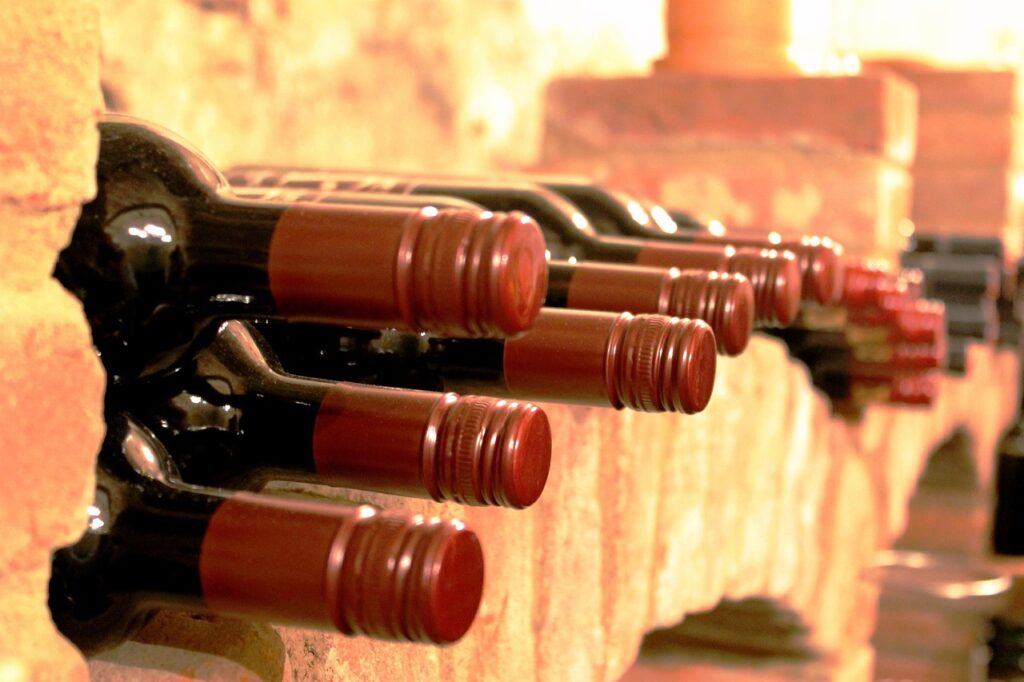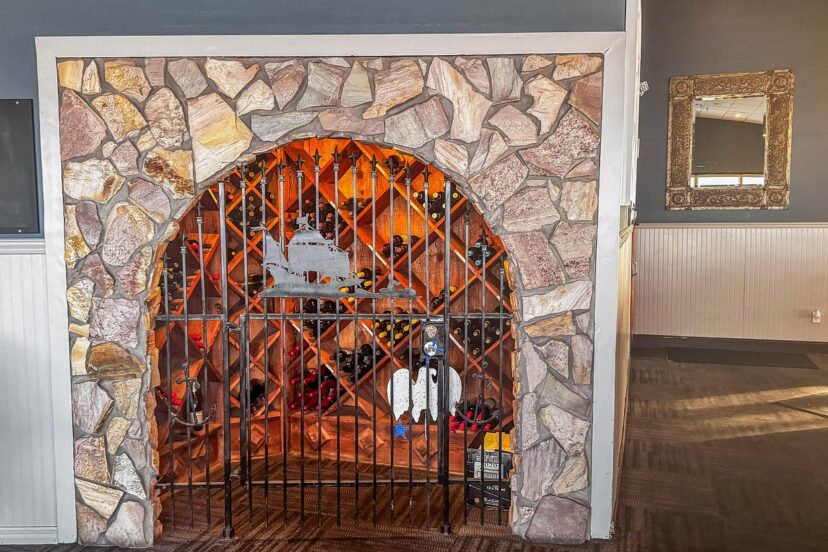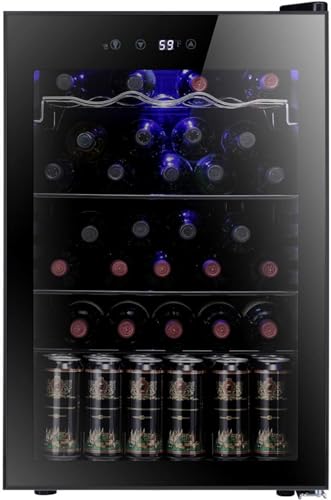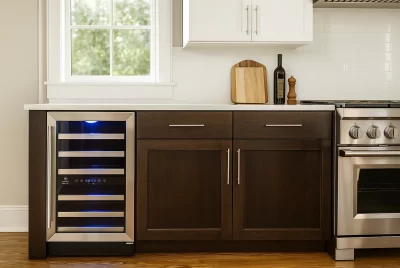How to Properly Store and Age Wine at Home
Post Disclaimer
*We may earn a commission for purchases made using our links. Please see our disclosure to learn more.
Wine is magic in a bottle, a living, breathing entity that tells a story of its origin, craft, and potential. As someone who has spent years exploring the intricate world of wine, I’ve learned that the journey of a great wine doesn’t end when you purchase it. The real magic happens in how you store and age wine at home.
Imagine uncorking a wine that has been carefully preserved, its flavors deepening and becoming more complex with time. This isn’t a fantasy for wine collectors; it’s a reality for those who understand the art and science of wine storage. Whether you’re a casual enthusiast with a few bottles or a serious collector building an impressive cellar, mastering the nuances of how to store and age wine at home can transform your wine experience.
Key Takeaways
- Temperature is the most critical factor in wine storage
- Humidity, light, and vibration can significantly impact wine quality
- Not all wines are meant to be aged
- Proper storage requires consistent environmental conditions
- Investing in the right storage solution can preserve and improve wine quality
The Complex Chemistry of Wine Aging
Wine is far more than just fermented grape juice. It is a dynamic and evolving liquid, a complex chemical symphony that transforms over time. From the moment it is bottled, a well-made wine continues to change, developing intricate flavor profiles, softening tannins, and unlocking hidden layers of aroma and texture. When you store and age wine at home under optimal conditions, this evolution enhances the drinking experience, turning a simple beverage into an exquisite and memorable indulgence.
The Molecular Magic of Aging
At a molecular level, wine undergoes fascinating transformations during storage. These changes are driven by a series of slow but significant chemical reactions that alter its taste, texture, and aromatic composition. Some of the most important processes include:
- Tannin Polymerization – Tannins, the naturally occurring polyphenols in wine, gradually bind together, forming larger molecules that result in a smoother, more velvety mouthfeel. This is particularly evident in red wines, where harsh astringency mellows over time.
- Acid Breakdown and Balance – Acidity is crucial to a wine’s freshness, but over time, certain acids break down and transform, reducing sharpness and contributing to a more harmonious flavor profile.
- Aromatic Evolution – The primary fruit aromas of young wine develop into more complex secondary and tertiary aromas. Fruity notes may give way to earthy, nutty, or floral nuances, creating greater depth and sophistication.
This transformation is not merely a passive process, it is a carefully orchestrated dance of chemistry, influenced by factors such as temperature, humidity, and oxygen exposure.
Temperature: The Make-or-Break Factor
Among the various conditions affecting wine aging, temperature is arguably the most crucial. Even the finest wine can degrade if exposed to improper temperatures. The ideal range of 52-58°F (11-14°C) is not arbitrary, it has been meticulously studied to provide the perfect balance between aging and preservation.
Temperature Impact Breakdown:
- Below 45°F (7°C): Chemical interactions slow to a near halt, significantly delaying maturation. This can cause wine to remain closed-off in flavor.
- 45-52°F (7-11°C): Aging occurs at a very slow pace, which can be beneficial for some wines but may lead to flavor stagnation in others.
- 52-58°F (11-14°C): The optimal range for controlled aging, allowing for gradual development of complexity while maintaining structural integrity.
- 58-70°F (14-21°C): Accelerated aging takes place, potentially leading to premature oxidation and loss of delicate aromas.
- Above 70°F (21°C): Chemical reactions become too aggressive, causing rapid oxidation, spoilage, and ultimately the destruction of wine’s nuanced character.
Maintaining a consistent temperature within the ideal range is essential to ensure a wine ages gracefully rather than deteriorating prematurely.
Humidity: The Unsung Hero of Wine Preservation
While temperature gets most of the attention, humidity plays a silent but vital role in ensuring wine’s longevity. When you store and age wine at home, maintaining the recommended 50-80% humidity range is more than just a suggestion, it is a crucial factor in preserving cork integrity and preventing unwanted oxidation.
Humidity’s Critical Role:
- Prevents Cork Drying – If humidity drops too low, corks can dry out and shrink, allowing excess oxygen to seep into the bottle and spoil the wine.
- Maintains Seal Integrity – Proper humidity keeps corks properly expanded, ensuring a tight seal that protects against oxidation and contamination.
- Protects Against External Contamination – A well-sealed bottle prevents unwanted influences from the external environment, such as mold growth or chemical exposure.
- Supports Gradual, Controlled Aging – The combination of appropriate humidity and temperature helps wine age in a steady and predictable manner, enhancing its character rather than degrading it.
Advanced Wine Storage Strategies
Proper wine storage is essential for preserving flavor, aroma, and quality over time. Whether you’re a professional collector or a home enthusiast, knowing how to store and age wine at home is both a science and an art, requiring careful attention to environmental factors. Below are advanced strategies to optimize your wine preservation and ensure each bottle reaches its full potential.
Creating the Perfect Storage Environment
A well-designed wine storage system safeguards against environmental fluctuations that can deteriorate wine quality. Here’s how to create optimal conditions for long-term preservation:
1. Temperature and Humidity Control
Maintaining a consistent climate is critical for preventing premature aging and spoilage.
- Ideal Temperature Range: Store wine between 50-59°F (10-15°C) to maintain flavor balance.
- Humidity Levels: Aim for 60-70% humidity to prevent corks from drying out and allowing oxidation.
- Avoid Fluctuations: Temperature swings can cause wine to expand and contract, risking leakage and spoilage.
Pro Tips:
- Use a temperature-controlled wine fridge or cellar for precision.
- Invest in a hygrometer to monitor humidity levels.
- Avoid placing wine storage near heat sources, such as ovens, radiators, or direct sunlight.
2. Vibration Control
Vibrations can disturb wine’s natural aging process by disrupting sediment and altering its composition.
- Choose Stable Storage Surfaces: Install wine racks on solid, vibration-free surfaces.
- Avoid High-Traffic Areas: Keep wine away from washing machines, dryers, loudspeakers, or heavy foot traffic zones.
- Use Anti-Vibration Solutions: Consider specialized wine storage units designed with anti-vibration technology to protect delicate vintages.
3. Light Management
Excessive light, especially UV rays, can break down wine’s chemical structure, leading to flavor degradation.
- Opt for UV Protection: Use UV-filtered glass or opaque wine cabinets for storage.
- Control Lighting: Implement dim, indirect lighting to prevent heat buildup and light exposure.
- Avoid Sunlight: Never store wine in direct sunlight or under harsh artificial lighting.
4. Positioning Precision
Proper bottle orientation ensures optimal cork integrity and minimizes oxidation risks.
- Store Corked Bottles Horizontally: This keeps the cork moist, preventing air from seeping in and oxidizing the wine.
- Use Specialized Racks: Invest in sturdy wine racks that prevent excessive bottle movement.
- Adjust Angles for Aging Needs: Some experts recommend slight angle variations for different wine types, ensuring sediment settles properly.
Wine Selection for Aging
Not all wines benefit from extended storage. Knowing which wines improve with age, and which should be consumed sooner, helps maximize your collection’s value.
Aging Potential Hierarchy
Exceptional Aging Potential (10-30+ years)
These wines develop greater complexity and depth over decades:
- High-tannin red wines (e.g., Nebbiolo, Cabernet Sauvignon)
- Premium Bordeaux blends
- Vintage Champagnes
- Top-tier Barolos and Brunellos
Good Aging Potential (5-10 years)
These wines mature well but don’t require decades to reach peak quality:
- Mid-tier Cabernet Sauvignons
- Complex Chardonnays (with oak aging)
- Some Italian and Spanish reds (e.g., Rioja Gran Reserva, Super Tuscans)
Limited Aging Potential (1-3 years)
Most wines in this category are best enjoyed fresh:
- Most white wines (Sauvignon Blanc, Pinot Grigio)
- Rosé wines
- Light-bodied reds (Beaujolais, Gamay, some Pinot Noirs)
- Inexpensive table wines
Budget-Friendly Storage Solutions
You don’t need to be a millionaire to store your wine collection properly. With the right strategies, you can create an ideal wine storage environment without breaking the bank. Whether you’re a casual enthusiast or an aspiring collector, there are practical solutions available for every budget.
Economic Options: Affordable Yet Effective Storage
For those looking to store wine on a budget, there are several cost-effective solutions that maintain wine quality without requiring major investments.
1. Dedicated Wine Coolers ($200-$500)
The Antarctic Star 36 Bottle Wine Cooler is the perfect addition to any home bar, kitchen, or entertainment space. With a spacious 4.4 cubic feet capacity, this freestanding wine cellar keeps your favorite wines, beers, and beverages at the optimal temperature. The quiet compressor cooling system ensures a disturbance-free experience, while the adjustable temperature control (32°F-61°F) allows for precise chilling. Featuring a reinforced glass door, soft LED lighting, and removable shelves, this sleek black fridge combines functionality with modern aesthetics.
- Spacious Capacity: Holds up to 36 standard bottles, making it ideal for wine collectors and beverage enthusiasts.
- Quiet Operation: Advanced compressor cooling system runs efficiently with minimal noise and vibration.
- Sleek Design:Reinforced glass door with blue LED lighting adds a stylish touch to any space.
- Freestanding Only: Cannot be built into cabinetry, requiring dedicated floor space.
- Manual Defrost: Requires occasional maintenance to prevent ice buildup.
- Limited Temperature Range: While ideal for wine, it may not be cold enough for certain beverages.
- A small wine cooler is a great entry-level storage option, keeping wine at a stable temperature.
- Many affordable models offer adjustable temperature settings, ensuring both red and white wines are stored properly.
- Best for small collections (6-50 bottles).
2. Cool, Dark Closet Spaces
- If a wine fridge isn’t an option, a dark, interior closet can provide decent storage.
- Choose a location away from direct sunlight and heat sources (such as furnaces or water heaters).
- Ideal for short-term storage of up to a few years.
3. Basement Storage with Temperature Control
- A naturally cool basement can mimic the conditions of a traditional wine cellar.
- If temperature fluctuations are a concern, a portable cooling unit or dehumidifier can help maintain stability.
- Works best for moderate-sized collections (50-150 bottles).
4. Insulated Wine Cabinets
- An insulated wine cabinet or repurposed wooden storage unit can protect wine from temperature swings.
- Consider adding foam insulation or reflective panels to maintain a stable climate.
- Suitable for those who want aesthetic storage on a budget.
Mid-Range Solutions: Enhanced Wine Preservation
For collectors looking to take wine storage to the next level without going fully custom, mid-range solutions provide better temperature control and organization.
1. Multi-Zone Wine Refrigerators ($500-$1,500)
The Velieta 24-Inch Dual Zone Wine & Beverage Refrigerator is the perfect solution for wine lovers and beverage enthusiasts. With independent cooling zones, you can store up to 18 wine bottles and 88 cans at their optimal temperatures. The powerful yet quiet compressor ensures efficient cooling, while the built-in air circulation system prevents odors and maintains freshness. Featuring touch control, blue LED lighting, and a front-vented design, this fridge can be installed as a built-in or freestanding unit to suit your space and style.
- Dual Cooling Zones: Separate wine (41°F-64°F) and beverage (35°F-50°F)sections for precise temperature control.
- Versatile Installation: Can be built-in under counters or used as a freestanding unit.
- Spacious Storage: Holds up to 18 wine bottles and 88 cans, with removable shelves for flexible organization.
- No Energy Star Certification: May consume more energy compared to certified models.
- Premium Price: Higher cost than single-zone or smaller refrigerators.
- Limited Bottle Size Compatibility: Larger wine bottles may require adjusting shelves, reducing overall capacity.
- These fridges offer separate temperature zones for red and white wines.
- Some models include UV-protected glass doors and vibration control technology.
- Great for enthusiasts with growing collections (50-200 bottles).
2. Dedicated Wine Storage Rooms
- Converting a spare room, pantry, or under-the-stairs space into a mini wine cellar can be an effective mid-range solution.
- Adding temperature control, shelving, and proper insulation creates a suitable environment.
- Best for collectors looking to store 200+ bottles.
3. Professional-Grade Cooling Units
- Installing a self-contained wine cooling system can regulate temperature and humidity.
- These units are available for small rooms, converted closets, or custom cabinets.
- Ideal for long-term wine aging without needing a full cellar.
High-End Storage: Premium Preservation for Serious Collectors

For those with extensive wine collections or fine vintages that require optimal conditions, high-end storage options offer superior preservation and long-term aging solutions.
1. Custom-Built Wine Cellars ($10,000+)
- A fully customized wine cellar provides the best conditions for aging wines.
- Includes temperature control, humidity regulation, and custom shelving.
- Designed to store hundreds to thousands of bottles.
2. Climate-Controlled Storage Rooms
- A dedicated room with professional-grade climate control ensures wines age perfectly.
- Often includes built-in racks, smart humidity monitors, and LED lighting.
- Ideal for those who entertain guests and want a functional yet elegant wine display.
3. Professional Wine Storage Services
- For rare or valuable collections, off-site wine storage facilities provide optimal aging conditions.
- Facilities feature security, backup power, and insurance options for added protection.
- Perfect for investors or collectors with limited home storage space.
Conclusion
Wine storage is an investment in pleasure and craftsmanship. Each bottle holds a story shaped through time, the vineyard, and the hands of the winemaker. Properly learning how to store and age wine at home ensures that story unfolds perfectly when uncorked.
Mastering temperature control, humidity management, vibration reduction, and proper bottle positioning transforms a casual wine drinker into a true custodian. Budget-friendly options and high-end solutions both contribute to maintaining quality and enhancing flavor.
Well-preserved wine develops deeper aromas and richer flavors, creating a rewarding experience with every sip. A carefully stored and aged collection brings joy and appreciation for the art of winemaking.
Wine is meant to be enjoyed. Thoughtful storage guarantees that every bottle reaches its full potential, turning each glass into a celebration of patience and craftsmanship.
Frequently Asked Questions
1. How important is precise temperature control?
Maintaining a stable temperature within 2-3 degrees of the ideal 55°F (13°C) is crucial. Fluctuations are more harmful than a slight variation from the perfect number. Consistency helps preserve flavors and prevent premature aging.
2. Can a standard home refrigerator work for wine storage?
Regular refrigerators are too cold and dry, which can damage wine by drying out the cork and altering its chemical balance. Wine coolers or dedicated storage solutions provide the correct temperature and humidity for long-term preservation.
3. How can I tell if a wine has been improperly stored?
Signs of poor storage include a protruding cork, excessive sediment, an off-putting smell, or a noticeable change in color. A wine that has turned brownish or brick-red when it should be vibrant is likely damaged.
4. Are wine preservation systems worth investing in?
For collectors with valuable or aged wines, preservation systems like Coravin or vacuum-sealed stoppers help extend a bottle’s life after opening. Casual drinkers may find a good wine cooler sufficient for maintaining quality.
5. Can I store red and white wines together?
If possible, store them in separate temperature zones. Red wines prefer 55-65°F (13-18°C), while white wines and sparkling wines need 45-55°F (7-13°C). If separate storage isn’t available, 55°F serves as a reasonable compromise for both.
Proper storage ensures every bottle remains at its best, preserving flavor, aroma, and quality for years to come.










